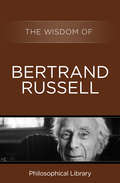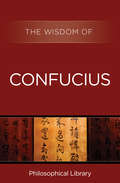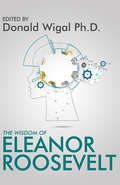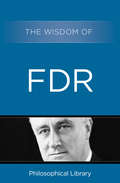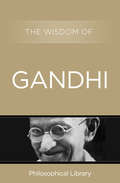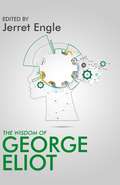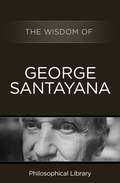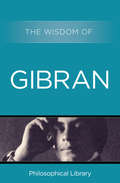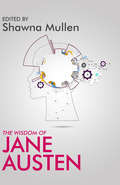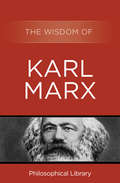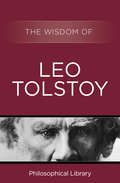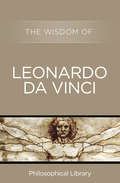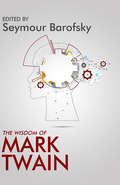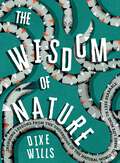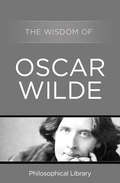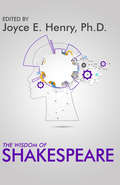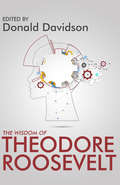- Table View
- List View
The Wisdom of Bertrand Russell (Wisdom)
by The Wisdom SeriesAn A-to-Z compendium of Russell&’s writingOne of the great minds of the twentieth century, Bertrand Russell explored philosophy, mathematics, and a variety of other intellectual, political, historical, and social issues in his lifetime. In this indispensable and easily accessible guide, drawn from his books and essays, readers will find Russell&’s fundamental principles, from objectivity to ontological arguments to logical certainty, in his own words. Russell also explored topics such as war, evil, and the purpose and goal of human existence. Russell&’s intellect transcends time and remains a relevant source of inspiration and thought today.
The Wisdom of Confucius (Wisdom)
by The Wisdom SeriesHundreds of sage observations from China&’s most revered scholar Teacher, politician, philosopher, and student, Confucius offered wisdom and aphorisms on a variety of topics that transcend borders and time. Whether considering his own life, human nature, or a society&’s responsibilities, Confucius&’s teachings emphasize personal and governmental morality, correctness of social relationships, justice, and sincerity. He aimed to effect social and political reform, and left a legacy of wisdom that remains true today. Organized by topic and accompanied with contextual footnotes, this collection of quotes, sayings, and lessons is often as entertaining as it is educational.
The Wisdom of Confucius (Wisdom)
by The Wisdom SeriesHundreds of sage observations from China&’s most revered scholar Teacher, politician, philosopher, and student, Confucius offered wisdom and aphorisms on a variety of topics that transcend borders and time. Whether considering his own life, human nature, or a society&’s responsibilities, Confucius&’s teachings emphasize personal and governmental morality, correctness of social relationships, justice, and sincerity. He aimed to effect social and political reform, and left a legacy of wisdom that remains true today. Organized by topic and accompanied with contextual footnotes, this collection of quotes, sayings, and lessons is often as entertaining as it is educational.
The Wisdom of Eleanor Roosevelt
by The Wisdom SeriesThe men and women who shaped our world—in their own words. The Wisdom Library invites you on a journey through the lives and works of the world’s greatest thinkers and leaders. Compiled by scholars, this series presents excerpts from the most important and revealing writings of the most remarkable minds of all time. THE WISDOM OF ELEANOR ROOSEVELT “We must join in an effort to use all knowledge for the good of all human beings. When we do that we shall have nothing to fear.” John F. Kennedy described Eleanor Roosevelt as “one of the great ladies in the history of this country.” A role model for generations of women, Mrs. Roosevelt made an indelible mark as First Lady. Although painfully shy, she never hesitated to publicly champion the poor, minorities, women and other victims of discrimination. She was among the twentieth century’s most active civil rights pioneers, compelling her husband to sign a series of Executive Orders barring discrimination in the administration of various New Deal projects, and supporting desegregation of the armed forces. Her groundbreaking column, “My Day,” ran in national newspapers for twenty-six years. During her tenure as U.S. delegate to the United Nations, she was the principal author of the Universal Declaration of Human Rights. She also maintained close friendships and correspondences with notable statespeople, including her husband’s successor, Harry S. Truman, who declared her “First Lady of the World.” With revealing excerpts from her letters and published work, The Wisdom of Eleanor Roosevelt delves into the passions and concerns that drove this exceptional humanitarian. Here is a fascinating and essential tribute to a woman ahead of her time, whose actions truly conveyed her words, “The future belongs to those who believe in the beauty of their dreams.”
The Wisdom of FDR (Wisdom)
by The Wisdom SeriesHow a great American president communicated a changing worldview What made Franklin Delano Roosevelt an effective leader? His policies and decisions changed our nation&’s and the world&’s history. But more than his skill as a savvy politician and progressive thinker, FDR&’s ability to directly and eloquently voice his thoughts on national concerns, social change, and humanity spoke to and reached the hearts of his people. In this selection of quotes drawn from his speeches and papers, FDR&’s observations and opinions cover everything from faith, war, and peace, to religion, freedom, and the very definition of what it is to be an American. Essays include &“The Four Freedoms,&” &“We Belong to Many Races,&” &“True Education,&” &“The Rights of the Common Man,&” &“Dynamic Democracy,&” and &“Government with a Soul.&”
The Wisdom of Gandhi (Wisdom)
by Trudy S. SettelBe the Change. Drawn from Gandhi&’s own words, this collection shares one man&’s philosophy that changed world history. When the Indian people, inspired by the words of Mahatma Gandhi, overthrew British rule, they proved that great political change could exist without violence. Revered both as a saint and a master politician in his native country, Gandhi proffered a philosophy that combined Thoreau&’s doctrine of civil disobedience with many Hindu beliefs. A comprehensive introduction to this influential modern thinker, The Wisdom of Gandhi recounts his deeply held views on a variety of topics, including passive resistance, self-discipline, democracy, and even well-being. This is essential text for the history and political reader, as well as anyone looking for words to inspire change.
The Wisdom of George Eliot (The\philosophical Library)
by Jerret EngleThe Philosophical Library presents the most important thinkers through the ages and their most influential writings THE WISDOM OF GEORGE ELIOT “No soul is desolate as long as there is a human being for whom it can feel trust and reverence.”—Romola Virginia Woolf once hailed George Eliot’s masterpiece, Middlemarch, as “one of the few English novels written for grown-up people.” Certainly, Eliot was one of the greatest Victorian novelists, and her celebrated works include such classics as Mill on the Floss, Silas Marner, Adam Bede, and Daniel Deronda. Born Mary Ann Evans in 1819, George Eliot was an original, almost radical, thinker whose unorthodox lifestyle as a working woman living openly with her lover made her a social pariah and cost her dearly. Yet through her novels, which she called “experiments in life,” she found a huge public following for her gentle empathy and keen social observations. Her work endures, for though her characters’ world may be radically different from our own, they confront the same dilemmas of intellect and spirit that we struggle with today.
The Wisdom of George Santayana (Wisdom)
by The Wisdom SeriesA survey of the influential—and prolific—modern philosopher In dozens of books, magazine articles, and essays, George Santayana infused his philosophy with exquisite language, wit, and subtle humor, prompting one authority to state that he &“writes philosophy more beautifully than any other thinker since Plato.&” The Wisdom of George Santayana makes accessible both his ideas and his oft-quoted aphorisms on a variety of subjects including naturalism, creative imagination, and spirituality without dogma. Organized by books and essays, and highlighting key words and themes, this compilation is an excellent introduction to the man and his work.
The Wisdom of George Santayana (Wisdom)
by The Wisdom SeriesA survey of the influential—and prolific—modern philosopher In dozens of books, magazine articles, and essays, George Santayana infused his philosophy with exquisite language, wit, and subtle humor, prompting one authority to state that he &“writes philosophy more beautifully than any other thinker since Plato.&” The Wisdom of George Santayana makes accessible both his ideas and his oft-quoted aphorisms on a variety of subjects including naturalism, creative imagination, and spirituality without dogma. Organized by books and essays, and highlighting key words and themes, this compilation is an excellent introduction to the man and his work.
The Wisdom of Gibran (Wisdom)
by The Wisdom SeriesAn A-to-Z guide to the mystic poet&’s maxims and aphorisms An early twentieth-century Lebanese-American writer, Khalil Gibran instilled his poetry and art with his experiences in both the East and West. This selection of quotes, maxims, and aphorisms is drawn from such poems as &“Secrets of the Heart,&” &“Spirits Rebellious,&” and &“Broken Wings,&” as well as from his autobiography and essays. Gibran&’s words express a strong spirituality and mysticism and his voice offers a direct and at times optimistic view of the brotherhood of man. Addressing everything from love and death to Jesus, motherhood, and nature, Gibran&’s wisdom remains thought provoking and inspirational.
The Wisdom of Gibran (Wisdom)
by The Wisdom SeriesAn A-to-Z guide to the mystic poet&’s maxims and aphorisms An early twentieth-century Lebanese-American writer, Khalil Gibran instilled his poetry and art with his experiences in both the East and West. This selection of quotes, maxims, and aphorisms is drawn from such poems as &“Secrets of the Heart,&” &“Spirits Rebellious,&” and &“Broken Wings,&” as well as from his autobiography and essays. Gibran&’s words express a strong spirituality and mysticism and his voice offers a direct and at times optimistic view of the brotherhood of man. Addressing everything from love and death to Jesus, motherhood, and nature, Gibran&’s wisdom remains thought provoking and inspirational.
The Wisdom of Jane Austen
by Shawna MullenThe men and women who shaped our world—in their own words. The Wisdom Library invites you on a journey through the lives and works of the world’s greatest thinkers and leaders. Compiled by scholars, this series presents excerpts from the most important and revealing writings of the most remarkable minds of all time. THE WISDOM OF JANE AUSTEN “Nothing is more deceitful than the appearance of humility.” Few novelists are as beloved as Jane Austen. For more than 150 years, her books have been read and reread by fans who cherish her satirical wit and acute insight, and modern generations have discovered her irresistible characters through film and television adaptations. Though rooted in the social mores of the early nineteenth century, Jane Austen’s works are timelessly appealing, and her observations remain surprisingly relevant in our very different times. The Wisdom of Jane Austen gleans nuggets of advice—alternately reflective and savagely witty—from her impressive literary legacy and correspondence, revealing her views on subjects as diverse as love, marriage, education, fashion, friendship, pride, poverty, success, sense, and of course, sensibility. This collection of gems reveals the very essence of Jane Austen—delightfully, abundantly wise.
The Wisdom of John Adams
by Kees De MooyThe men and women who shaped our world—in their own words. The Wisdom Library invites you on a journey through the lives and works of the world’s greatest thinkers and leaders. Compiled by scholars, each book presents excerpts from the most important and revealing writings of the most remarkable minds of all time. THE WISDOM OF JOHN ADAMS “Straight is the gate and narrow is the way that leads to liberty, and few nations, if any, have found it.” John Adams was America’s second president, first vice president, and a leading revolutionary, yet his remarkable accomplishments have sometimes been overshadowed by his peers, Washington and Jefferson. David McCullough’s Pulitzer Prize-winning biography has helped reestablish Adams as a truly heroic figure in his own right—intelligent, passionate, fiercely patriotic, and staunchly committed to the ideals of the United States. Now The Wisdom of John Adams further reveals—in Adams’ own words—this distinguished leader’s brilliance, foresight, and conviction. Here are excerpts from his greatest speeches and published works, including his oration on independence in the Continental Congress; Thoughts on Government, later the guide for several state constitutions; and his three-volume Defense of the Constitution of the United States. The Wisdom of John Adams also includes a selection of his forthright correspondence, as well as his tender love letters to his wife and strongest ally, Abigail—in all, essential reading for any student of the “American Experiment.”
The Wisdom of Karl Marx (Wisdom)
by The Wisdom SeriesAn A-to-Z reference of the great social reformer&’s own words Among modern philosophers, few have had a greater impact on history than Karl Marx. Now this easy-to-use introduction to the nineteenth-century theorist breaks down his work into definitions of his terms and concepts, including Bourgeois State, Classless Society, and Freedom of the Press. Accompanied by an insightful introductory essay that puts the included excerpts from his works in context, The Wisdom of Marx is essential reading for an understanding of the man whose work incited far-reaching social and economic change.
The Wisdom of Karl Marx (Wisdom)
by The Wisdom SeriesAn A-to-Z reference of the great social reformer&’s own words Among modern philosophers, few have had a greater impact on history than Karl Marx. Now this easy-to-use introduction to the nineteenth-century theorist breaks down his work into definitions of his terms and concepts, including Bourgeois State, Classless Society, and Freedom of the Press. Accompanied by an insightful introductory essay that puts the included excerpts from his works in context, The Wisdom of Marx is essential reading for an understanding of the man whose work incited far-reaching social and economic change.
The Wisdom of Leo Tolstoy (Wisdom)
by The Wisdom SeriesFollow the renowned novelist&’s journey to his own peace Leo Tolstoy was born to an aristocratic Russian family, became a world-famous influential novelist, and then chose to lead the simple life of a peasant. Dating from this last part of his life, Tolstoy&’s influential book, What I Believe, takes readers along on the path to a life modeled literally on Jesus Christ&’s &“Sermon on the Mount&” and the teachings of the Gospels. In revealing and frank essays he reimagines a faith without dogma, centered solely on Jesus&’s doctrine of love, humility, and self-denial. This collection of chapters from What I Believe includes examinations of Resist Not Evil, Judge Not Thy Neighbor, Letting Go of Fear, and Allowing Forgiveness.
The Wisdom of Leo Tolstoy (Wisdom)
by The Wisdom SeriesFollow the renowned novelist&’s journey to his own peace Leo Tolstoy was born to an aristocratic Russian family, became a world-famous influential novelist, and then chose to lead the simple life of a peasant. Dating from this last part of his life, Tolstoy&’s influential book, What I Believe, takes readers along on the path to a life modeled literally on Jesus Christ&’s &“Sermon on the Mount&” and the teachings of the Gospels. In revealing and frank essays he reimagines a faith without dogma, centered solely on Jesus&’s doctrine of love, humility, and self-denial. This collection of chapters from What I Believe includes examinations of Resist Not Evil, Judge Not Thy Neighbor, Letting Go of Fear, and Allowing Forgiveness.
The Wisdom of Leonardo da Vinci (Wisdom)
by The Wisdom SeriesAn intriguing look inside the mind of the Renaissance genius Leonardo da Vinci stood on a bridge between medieval thought and the modern mind. In this selection of entries from his dozens of coded notebooks and unpublished manuscripts, his unending curiosity in the universe and deep knowledge come through in his energetic style. The self-educated da Vinci developed a philosophical system that set him apart from his contemporaries and marked him as the oracle of a new age, and his vivid imagination and straightforward writing style capture the reader&’s attention whether he is writing about his scientific analysis, his opinion of necromancy, discoveries in nature, or the nature of man. Accompanied by a thorough introduction, The Wisdom of Leonardo da Vinci unveils the man&’s deepest thoughts and musings and proves why he remains an intriguing and enduring figure.
The Wisdom of Mark Twain
by Seymour BarofskyThe men and women who shaped our world—in their own words. The Wisdom Library invites you on a journey through the lives and works of the world’s greatest thinkers and leaders. Compiled by scholars, this series presents excerpts from the most important and revealing writings of the most remarkable minds of all time. THE WISDOM OF MARK TWAIN “Let me make the superstitions of a nation and I care not who makes its laws or its songs either.” Mark Twain was a figure larger than life, and he remains to this day the most universally revered American writer of all time. In such classics as Life on the Mississippi, Tom Sawyer, and The Adventures of Huckleberry Finn he crafted stories of heroism, adventure, tragedy, and comedy that reflected the changing America of the time. He was also one of our greatest wits, a satirist and humanist who used humor and twists of the tongue to reveal his controversial opinions and trademark irreverent spirit. Ernest Hemingway called Twain’s The Adventures of Huckleberry Finn, “the best book we’ve ever had. There was nothing before. There’s been nothing as good since.” And author Russell Banks wrote that Twain “makes possible an American literature which would otherwise not have been possible.” Here in these pages is the inimitable and invaluable insight of Mark Twain gathered from his many books, short stories, essays, sketches, and speeches, as well as from travel writing and autobiographical pieces—a treasure trove of wisdom from one of American literature’s most beloved figures. “Love your enemy; it will scare the hell out of them.”
The Wisdom of Nature: Inspiring Lessons from the Underdogs of the Natural World to Make Life More or Less Bearable
by Dixe WillsAuthor and travel writer Dixe Wills likes to champion the underdog. In this new book, he celebrates 70 living things from the world of nature that are unfairly maligned by humans and yet manage to beat the odds in some inspiring or uplifting way.From bacteria and bluebottles, to puddles and wasps, there's so much we can learn from the curious creatures and the natural world around us. Take the slug, for example: "Slugs, like us, yearn to be the object of a little human love and sympathy. Unlike slugs, you have a chance of this dream coming true. Also, beer will not kill you. Not immediately, anyway."Written in Dixe's inimitable style, this charming book is sure to delight his many fans and gain him new readers with an interest in the natural world.
The Wisdom of Oscar Wilde (Wisdom)
by the Wisdom ofA comprehensive selection of his quips, aphorisms, and witOne of the most well known personalities of his day, Oscar Wilde charmed and beguiled readers and audiences with his eloquent and biting observations, his smart quips, and the witticisms peppering his own speech and the speech of his characters. The Wisdom of Oscar Wilde collects both his best-loved quotes and longer excerpts, revealing a man wise to human nature and his times, and never shy with his searing comments on men, women, art, behavior, children, politics, youth, and a range of other topics. Drawing from his plays, articles, reviews, speeches, letters, and other works, this definitive volume is an entertaining immersion into the world of this charming genius.
The Wisdom of Sartre (Wisdom)
by The Wisdom SeriesAn invaluable introduction to the leading French intellectual of the twentieth century The Wisdom of Sartre offers key excerpts from the eloquent French writer, playwright, and philosopher&’s masterpiece, Being and Nothingness. From this collection, readers will discover the strongest themes in his early philosophical work: an ontological account of what it means to be human, and the role of perception, knowledge, and consciousness in the practical demands of life. Sartre&’s view that man&’s freedom is a unique source of both misery and pleasure and that the question of which will prevail depends on man&’s awareness and commitment to his freedom is both thought provoking and timely.
The Wisdom of Shakespeare
by Joyce HenryIf the transparent pictures of a cinematograph roll were found clipped apart in a medley of separate pictures, the test of their reunion in a reconstituted film would be the air of life in the moving picture thrown from it on the shimmering screen. <P><P>And so it is with those elements of a living portrait to be found in the extra-dramatic bits of Shakespeare's work. This statement has been made before; has been supported; has been denied. The present writer says merely Read and judge.
The Wisdom of Steve Jobs
by Carol Kelly-GangiHundreds of quotations from the revolutionary Apple founder on topics from innovation and design to hiring and firing to family and personal fulfillment.During a career that spanned more than thirty-five years, Steve Jobs forever changed the way people communicate, listen to music, and watch video, among other things. This book brings together hundreds of quotations drawn from interviews, appearances, and media coverage over decades. Organized thematically, the selections reveal his insights and philosophies on everything from hiring, firing, and the workplace to competitors, family, and friends. In these selections, Jobs:Reflects on the goals, successes, and challenges of his business careerShares his deeply held views about the true meaning of design and product innovationSpeaks frankly about the high expectations he sets for colleagues as well as himselfOffers keen insights into how to live life to the fullest—both personally and professionallyIn more personal excerpts, the fiercely private Jobs recalls his childhood and the valuable lessons his parents taught him; his adolescent years; and his early passion for electronics, while also speaks lovingly about his wife and family. In addition, the book includes an assortment of quotations from world leaders, industry giants, politicians, journalists, and friends who share their insights.
The Wisdom of Theodore Roosevelt
by The Wisdom SeriesThe men and women who shaped our world—in their own words. The Wisdom Library invites you on a journey through the lives and works of the world’s greatest thinkers and leaders. Compiled by scholars, each book presents excerpts from the most important and revealing writings of the most remarkable minds of all time. THE WISDOM OF THEODORE ROOSEVELT “Order without liberty and liberty without order are equally destructive.” Politician. Statesman. Conservationist. Historian. Lawman. Soldier. Writer. Husband. Father. These are some of the hats Theodore Roosevelt wore during the course of an extraordinary public life. Though most famous for his two terms as President of the United States, Roosevelt was one of the true renaissance men of our time, and his writings, both published (he authored more than thirty-five books) and private (he kept up a network of correspondences that produced well over 150,000 letters) provide remarkable insight to the depth of his thinking, and his utter commitment to making his country the best it could be. Edmund Morris’s bestselling biography has brought attention to this complex and often controversial figure who, many believe, created the 20th-century presidency. Now, The Wisdom of Theodore Roosevelt presents a carefully culled selection of his words and ideas on a range of subjects, providing a fascinating portrait of Roosevelt’s personality and beliefs as they evolved over time. Here is an essential volume for students, historians, Americans, and all those who agree that “The only man who never makes a mistake is the man who never does anything.”
